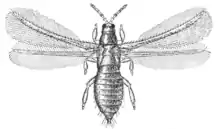Thripidae
The Thripidae are the most speciose family of thrips, with over 290 genera representing just over two thousand species.[2] They can be distinguished from other thrips by a saw-like ovipositor curving downwards, narrow wings with two veins, and antennae of six to ten antennomeres with stiletto-like forked sense cones on antennal segments III and IV.[3]
| Thripidae | |
|---|---|
 | |
| Pear thrips (Taeniothrips inconsequens) imago | |
| Scientific classification | |
| Domain: | Eukaryota |
| Kingdom: | Animalia |
| Phylum: | Arthropoda |
| Class: | Insecta |
| Order: | Thysanoptera |
| Suborder: | Terebrantia |
| Family: | Thripidae Stephens, 1829[1] |
| Diversity | |
| 4 subfamilies | |
They are considered to be among the more derived of thrips, having evolved many traits key to specializing as cryptophilous phytovores, living in the narrow spaces at the bases of leaves and within flowers.[4][5]
Several species are economically significant pests, some of them invasive. Almost all of them are typical thrips which belong in the largest subfamily, the Thripinae.
Systematics
Many of the divisions within the Thripidae are not based on common ancestry, but are instead based on common environment and morphological homoplasy, and these distinctions tend to be irrelevant to true phylogenetic relationships.[6] As a result, many species of the Thripidae have undergone recent drastic taxonomic revision, splitting and promoting two tribes, Dendrothripini and Sericothripini, to subfamily status,[7] with the possibility of greater reorganizations to come as modern phylogenetic methods and a more comprehensive morphological analysis provide additional evidence defining evolutionary relationships.[8] This revision is probably necessary, as more than half of the genera in family Thripidae are monobasic, with the majority of monotypic species concentrated in subfamily Thripinae.[9] However, a 2012 molecular phylogeny found that the Thripinae was paraphyletic; further work will be needed to clarify the relationships within the group.[10]
Subfamilies
The Thripidae are thus ordered into four subfamilies:
- Dendrothripinae Priesner, 1925 (16 genera)
- Panchaetothripinae Bagnall, 1912 (38 genera)
- Sericothripinae Karny, 1921 (11 genera)
- Thripinae (227 genera)
References
- Stephens, J.F. (1829). A systematic catalogue of British insects. London. p. 363.
- Mound, L. A. 2002. So many thrips – so few tospoviruses?, pp. 15 - 18. In L. A. Mound and R. Marullo [eds.], Thrips and Tospoviruses: Proceedings of the 7th International Symposium on Thysanoptera. CSIRO Entomology, Reggio Calabria, Italy.
- Mound, L. A. 1998. Thysanoptera: an identification guide. CAB International, Oxon, New York.
- Gentile, A. G., and S. F. Bailey. 1968. A revision of the genus Thrips Linnaeus in the New World, with a catalogue of world species (Thysanoptera: Thripidae). University of California Press, Berkeley, CA.
- Lewis, T. 1973. Thrips. Their biology, ecology and economic importance. Academic Press, London, GB.
- Mound, L. A., and D. C. Morris. 2004. Thysanoptera Phylogeny – the Morphological Background. Acta Phytopathologica et Entomologica Hungarica 39: 101 - 113.
- Moritz, G., D. C. Morris, and L. A. Mound. 2001. Thrips ID: an interactive identification and information system (CD), Pest thrips of the world. CSIRO Publishing, Collingwood, Australia.
- Grimaldi, D., A. Shmakov, and N. Fraser. 2004. Mesozoic Thrips, and early evolution of the Order Thysanoptera (Insecta). Journal of Paleontology 78: 941 - 952.
- Mound, L. A. 2005. Thysanoptera: diversity and interactions. Annual Review of Entomology 50: 247 - 269.
- Buckman, Rebecca S.; Mound, Laurence A.; Whiting, Michael F. (2012). "Phylogeny of thrips (Insecta: Thysanoptera) based on five molecular loci". Systematic Entomology. 38 (1): 123–133. doi:10.1111/j.1365-3113.2012.00650.x. S2CID 84909610.
Further reading
- Hoddle, M.S. & Mound, L.A. (2003). The genus Scirtothrips in Australia (Insecta, Thysanoptera, Thripidae). Zootaxa 268:1-40. PDF
External links
 Media related to Thripidae at Wikimedia Commons
Media related to Thripidae at Wikimedia Commons Data related to Thripidae at Wikispecies
Data related to Thripidae at Wikispecies- Thrips of the World Checklist: Family Thripidae
- Pictures of Taeniothrips inconsequens from Canada Archived 2006-10-02 at the Wayback Machine
- Chilli Thrips (castor thrips, Assam thrips, yellow tea thrips, strawberry thrips), Scirtothrips dorsalis Hood, Provisional Management Guidelines Archived 2011-08-07 at the Wayback Machine